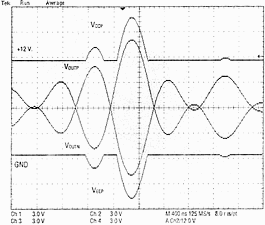'Adaptive linear' power amplifier increases power efficiency
9 October 2002
Analogue, Mixed Signal, LSI
Circuit designers are often faced with the problem of efficiently amplifying a signal that has occasional peaks that are much greater than the signal's RMS level. Until now, the only solution was to configure an amplifier with wide power supply rails, in excess of the maximum peak signal level. This resulted in an inefficient implementation that wasted power most of the time (except during the occasional peaks).
The AD8393 in single +12 V supply operation showing Adaptive Linear Power supplies and driver outputs. The internal supplies are brought outside the rails to accommodate peaks above 12 V and below GND
Analog Devices' AD8393 uses what it says is a breakthrough amplifier architecture called adaptive linear power, that dramatically improves power efficiency by responding to these signal peaks and instantaneously raising the internal supply voltage when peak power is needed. The AD8393 can deliver over 18 V of signal on a single 12 V supply (or ±6 V). This capability is particularly well suited as an ADSL-CO amplifier for driving DMT (discrete multitone) signals onto a twisted pair line with a peak-to-rms ratio range up to 6,4. Operation from a single 12 V supply further reduces power consumption and system complexity.
Audio and medical applications that require the efficient amplification of signals with occasional peaks will benefit from the device and the Adaptive Linear Power implementation. It is available in CSP and TSSOP packages.
Further reading:
Ultra-low power MEMS accelerometer
Altron Arrow
Analogue, Mixed Signal, LSI
Analog Devices’ ADXL366 is an ultra-low power, 3-axis MEMS accelerometer that consumes only 0,96 µA at a 100 Hz output data rate and 191 nA when in motion-triggered wake-up mode.
Read more...
BT Audio 4 Click board
Dizzy Enterprises
Analogue, Mixed Signal, LSI
The BT Audio 4 Click board from MIKROE provides high-quality wireless audio streaming and data comms over Bluetooth.
Read more...
Precision MEMS IMU modules
Altron Arrow
Analogue, Mixed Signal, LSI
The ADIS16575/ADIS16576/ADIS16577 from Analog Devices are precision, MEMS IMUs that includes a triaxial gyroscope and a triaxial accelerometer.
Read more...
MEMS with embedded AI processing
Altron Arrow
Analogue, Mixed Signal, LSI
STMicroelectronics has announced an inertial measurement unit that combines sensors tuned for activity tracking and high-g impact measurement into a single, space-saving package.
Read more...
High-performance IMU
RS South Africa
Analogue, Mixed Signal, LSI
TDK Corporation has announced availability of the new InvenSense SmartMotion ICM-536xx family of high-performance 6-axis IMUs.
Read more...
High-temperature closed-loop MEMS accelerometer
RS South Africa
Analogue, Mixed Signal, LSI
This sensor from TDK is a high-temperature MEMS accelerometer with ±14 g input range and a digital interface for measurement while drilling applications.
Read more...
Dual accelerometers on the same die
Altron Arrow
Analogue, Mixed Signal, LSI
The LSM6DSV320X is the first mainstream inertial sensor to house a gyroscope alongside two accelerometers, one capable of sensing up to ±16 g and one sensing up to a staggering ±320 g.
Read more...
Dual-range IMU with edge processing
EBV Electrolink
Analogue, Mixed Signal, LSI
ST’s innovative LSM6DSV80X combines two accelerometer structures for 16 g and 80 g full-scale sensing, a gyroscope up 4000 dps, and embedded intelligence in a single component.
Read more...
High-reliability isolation amplifiers
EBV Electrolink
Analogue, Mixed Signal, LSI
The VIA series of isolation amplifiers from Vishay are designed to deliver exceptional thermal stability and precise measurement capabilities.
Read more...
Mibbo QT2C Series signal isolators
Conical Technologies
Analogue, Mixed Signal, LSI
The Mibbo QT2C Series isolators support a rich combination of input and output signals, working with either current loops or voltage levels.
Read more...


